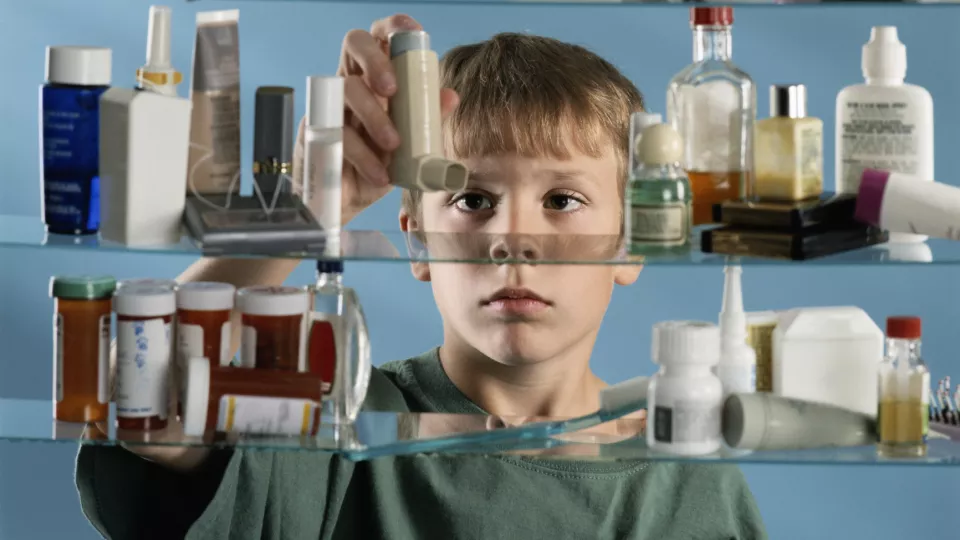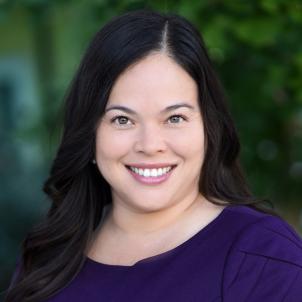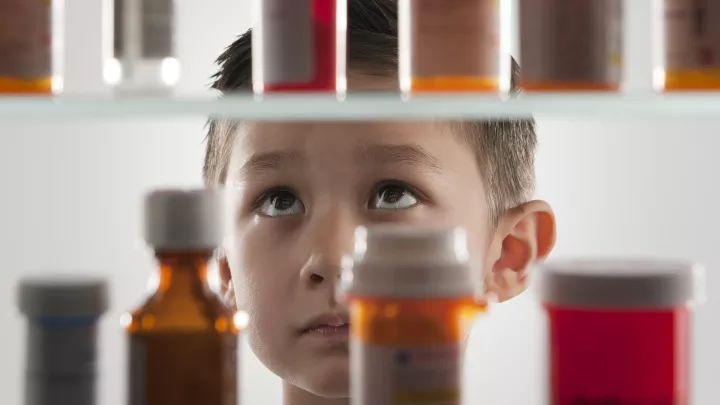
Five Keys to Effective Medication Safety at Home
Children's Hospital Los Angeles has long been a forceful leader on the issue of medication safety, advising parents on what they can do at home to prevent their kids from ingesting prescription drugs that can do them great harm.
Effective medication safety requires adhering to a few simple rules. We break those down here with the guidance of Helen Arbogast, DrPH, MPH, Manager of CHLA’s Injury Prevention Program, and CHLA pediatric surgeon Lorraine Kelley-Quon, MD, MSHS, FACS, FAAP, who oversees the Health Outcomes and Policy Effects (HOPE) Laboratory, which devotes a good portion of its research to studying the risks associated with opioid use for infants, children and adolescents.
Lock up your medications. “The general rule is keep them up and away,” Dr. Arbogast says. That means tucked in cabinets that are out of the reach of small children.

Little kids are inquisitive climbers, though, so those medicine cabinets should be locked up for another level of protection. If families don’t have a cabinet that locks, childproof cabinet locks are available so children can't access the medication even if they manage to reach it.
Just as critical is keeping medication in its original, childproof container provided by the pharmacy. Dr. Arbogast warns against moving pills into a Sunday-through-Saturday pill box, which children can easily pop open. She also urges parents to be watchful with edible forms of cannabis—known as edibles. They often resemble treats, which of course makes them appealing to small children. The same rule applies: Keep them out of reach and locked up.
Get rid of what you don’t use. Having medication around the house that you don’t intend to use creates unnecessary risk. Generally, medications go unused because they are no longer needed or wanted, or have expired and are no longer effective. For any of those reasons, treat medication as a waste product and throw it out. Discarding it will keep young children from having any chance of swallowing it.
“Sometimes we just leave medications around because we don't know where to toss them,” Dr. Arbogast says. “Make sure you safely dispose of them so they’re not in the house.”
Throw them out where, though? That’s important as well, Dr. Arbogast says. She emphasizes that medication needs to be disposed of responsibly, rather than dumped thoughtlessly into a garbage bin. She directs people to the Food and Drug Administration’s proper ways to get rid of unused medications, which includes safely placing them in your household trash or returning them to the pharmacy.
A third option on the FDA site—flushing leftover medications—is a bit problematic because it may have an environmental impact. While the site includes a list of drugs that it says are acceptable for flushing, the Environmental Protection Agency (EPA) asks people to minimize flushing medications to decrease contamination of the water supply and wildlife.
Dr. Kelley-Quon suggests that a better choice for disposing of medications, particularly opioids, is bringing them to a drug take-back event held by the Drug Enforcement Agency. (CHLA hosted one of its own previously.) “DEA-sponsored drug take-back events or disposal bins are preferable to flushing,” she says.
Beware of opioids. Opioids require parents’ extra attention. They’re at the center of an epidemic of addiction in the U.S. and have caused scores of fatalities among U.S. youth. So the potential dangers connected to leaving excess pills around the house are amplified when the pills are opioids—and the warnings go up in intensity.

As opioids are prescribed for pain relief, users often don’t finish the entire bottle once their pain subsides. That leaves a surplus of unused pills from the initial supply, which creates a threat to both young children, who can get into them accidentally, and teens, who may go searching for them. CHLA offers families a safe way of discarding them. The hospital has a federally approved opioid disposal bin located on the first floor, outside the outpatient pharmacy.
Dr. Kelley-Quon adds a warning. "If there are opioids in the house,” she says, “parents need to be aware of the signs of opioid overdose—small pupils, slowed breathing, lethargy.”
She instructs parents to have in their home a medication called naloxone (brand name Narcan) an intranasal spray that can be given in case of an overdose to immediately reverse the effects of opioids. “Two-thirds of teens who overdose do it with a bystander present who could have intervened,” Dr. Kelley-Quon says.
Educate the whole family. In many households, especially those with little kids, circumstances force parents to call on extended family members to pitch in with child care. The first call often goes out to the grandparents, who may not have a childproofed home.
“Now grandma’s doing the work and it's been a long time since she's had a small child,” Dr. Arbogast says. “So she doesn't even think to put her heart medication away.”
Dr. Arbogast says to make sure that all family members, or friends, who are providing substitute child care follow the same medication safety practices as you do, and to remind them to put away all pill bottles.
Save the number to Poison Control. Despite parents’ best efforts, accidents happen. It’s impossible to account for every means that small children have for getting into things not meant for them. So it’s important to have the number to California Poison Control on hand.
If you believe your child has swallowed a toxic substance, call 1-800-222-1222—available 24 hours a day, 365 days a year.
“Everybody knows 911,” Dr. Arbogast says, “but not everybody knows the California Poison Control number.” Her team hands out magnets that display it so families don't have to go searching for it in an emergency.
Dr. Arbogast says to call the number immediately if you suspect your child has swallowed a medication that could be toxic for children. Don't wait for your child to have an adverse reaction to confirm it because reactions will vary by the substance consumed.
“Some may cause vomiting; some may cause lethargy where the kid is kind of nonresponsive; some might cause a stomach illness,” she says.
Let the professionals at Poison Control determine next steps once you explain your child's size and symptoms and whatever drug was thought to be ingested.


